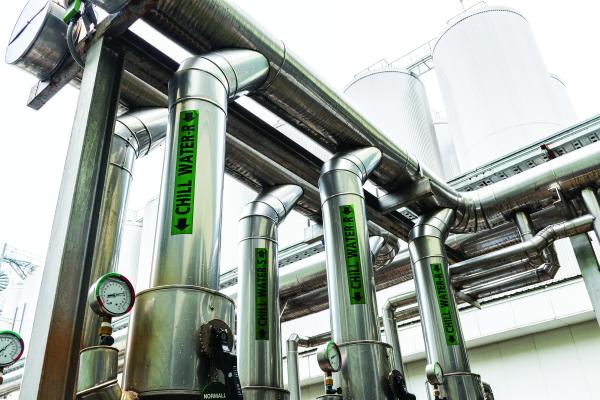Refrigeration Compressors
The AIM (American Innovation and Manufacturing) Act was finalized by the US government at the end of 2021. This legislation introduced a phase-down plan for virgin HFC gases. From now through 2036, the US will reduce the production and importation of virgin HFCs by granting relevant businesses a set number of HFC allowances (or quota), which will decrease over time.
Danfoss Turbocor held a grand opening of its new 145,000-square-foot production facility in Tallahassee, Florida, on May 29, 2024. The $62 million investment will double the manufacturing capacity for Turbocor oil-free centrifugal, magnetic-bearing, variable-speed compressors, with the ability to expand capacity even further. This report will recap the celebration and plant tour while sharing perspective from the attendees and host.
[ Read Full Story ]
A total of 1,875 exhibitors spread across 527,520 square feet, and 120 free educational sessions drew 48,034 total attendees. Driven by decarbonization and green transition megatrends, this event highlighted the global refrigerant transition; adoption of heat pumps; integration of building automation systems and AI; and optimization of the energy/water nexus in applied equipment. This article recaps the response and innovation from manufacturers of chillers, cooling towers and related equipment.
[ Read Full Story ]
The electrification of heating presents a significant opportunity to achieve decarbonization goals by reducing or eliminating the use of fossil fuels in traditional building systems such as boilers. The current geopolitical scenario has caused commodity prices to quickly rise and forced businesses, cities and countries to rethink their future dependance on fossil fuels and accelerate the conversion to sustainable alternatives.
[ Read Full Story ]
The 2022 AHR Expo co-sponsored by ASHRAE and AHRI was held Jan. 31 – Feb. 2, at the Las Vegas Convention Center. A total of 1,573 exhibitors (281 international) spread out over 440,000 square-feet, and 80 free sessions in the Education Program drew more than 30,000 attendees to the event. Common trends discussed amongst exhibitors focused on energy efficiency, operational reliability, connectivity and new chiller refrigerant transitions spurred by approaching regulatory transition dates in the AIM Act enacted by US Congress in late 2020.
[ Read Full Story ]
The inefficiency of fossil fuels, along with the negative environmental impact coming from their burning and resulting emissions, is driving companies to find alternative heating and cooling solutions. While renewable sources – such as wind and solar power – are decreasing this impact, other fossil fuel-burning sources need to be replaced with electric-driven alternatives to fully realize their emissions reduction potential. New vapor compression technology can help reduce heating and cooling operations while providing these additional CO2 emissions reductions.
[ Read Full Story ]
Recent legislation is impacting the use of hydrofluorocarbon (HFC) refrigerants, both globally and nationally. On the heels of these changes is confusion about legislation and the availability of certain types of refrigerants. On a global scale, the Kigali Amendment to the Montreal Protocol provides a global phase-down schedule for the use of HFC refrigerants in multiple sectors - including R-134a and R-410A - for the HVAC/R industry. While ratified across the globe by approximately 100 countries to date, the amendment has yet to be ratified in the United States.
[ Read Full Story ]
Oil-free refrigeration compressor technology offers significant benefits in terms of efficiency and performance. Eliminating oil from the system can yield up to 40% improvement in part-load efficiency compared to fixed speed screw compressors. And, this performance improvement can be sustained over the life of the compressor since oil-free compressors incur no mechanical wear during operation.
[ Read Full Story ]
In recent years, the HVAC industry has enlarged its vision from focusing on equipment efficiency measured in terms of ratings points at specific conditions to include a whole building perspective that uses models of year-long, real-world conditions. Accordingly, energy standards have adopted new rating methods to evaluate equipment efficiency during part-load operation. In Part 1 of this two-part article series we examined how these standards are evolving.
[ Read Full Story ]
This first article will examine the evolution of equipment-efficiency standards from full to part load and their relationship to whole-building efficiency. The second article will look at how HVAC technologies are advancing to modulate capacity to match variations in building loads, a major factor in improving whole-building energy performance.
[ Read Full Story ]
Xcel Energy is headquartered in Minneapolis, Minnesota, and is the largest electrical energy provider in Colorado. The company recently upgraded its refrigerant monitoring systems at its Chilled Water building in downtown Denver, creating an efficient and reliable method for continuous monitoring of refrigerant used in 16 chillers in different locations – while supporting the need for safety, system performance, and reductions in energy and refrigerant costs.
[ Read Full Story ]

